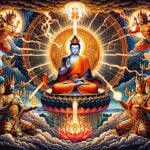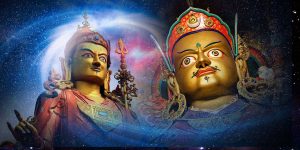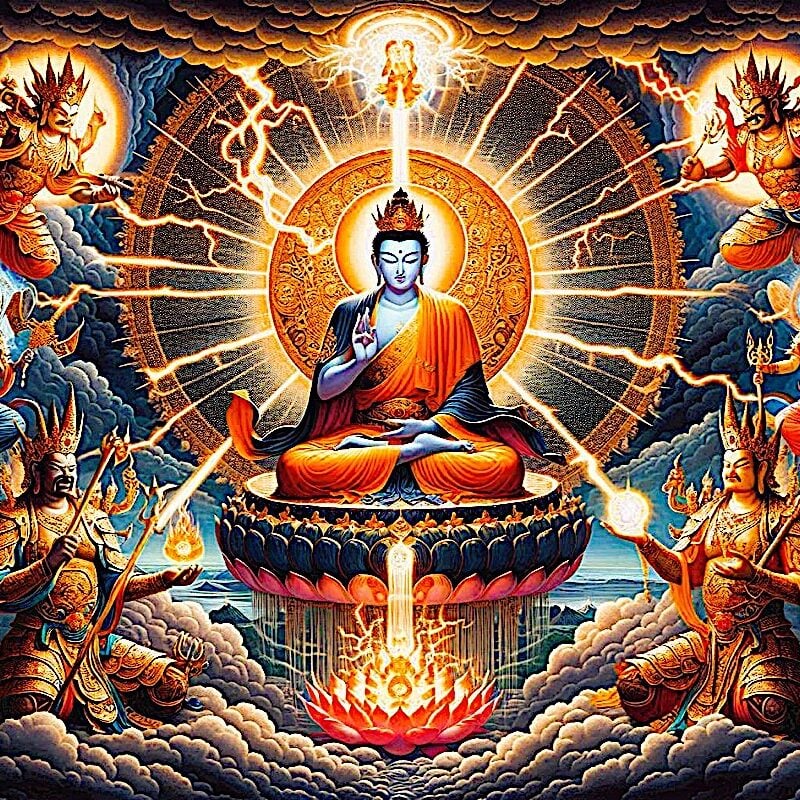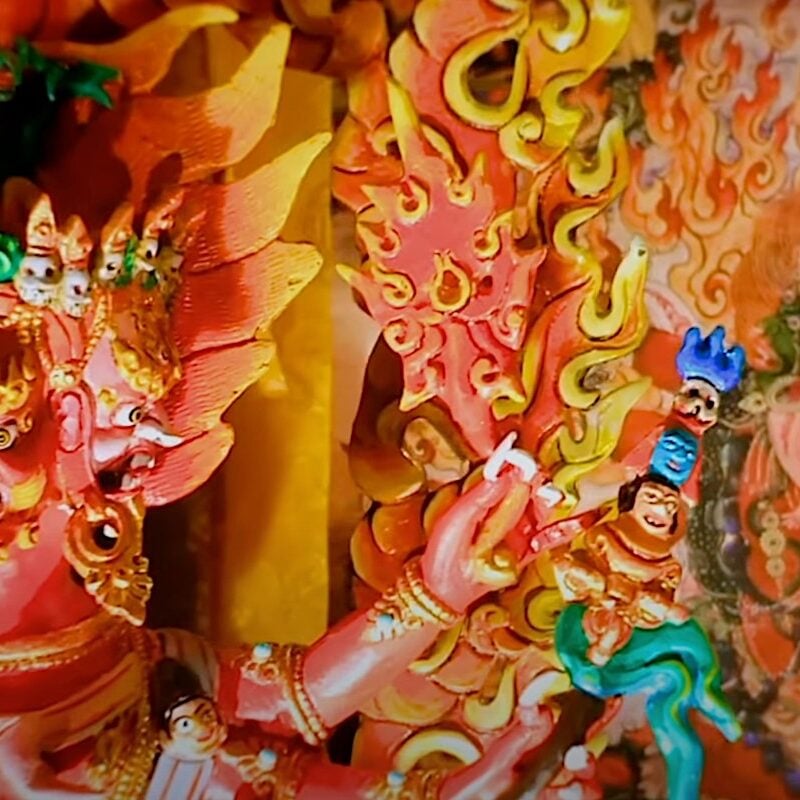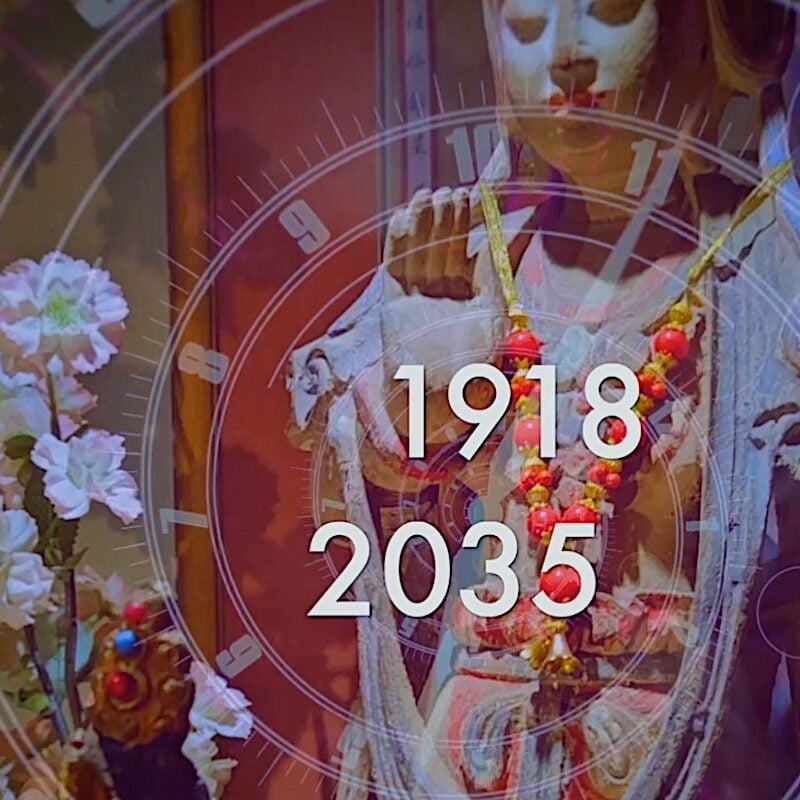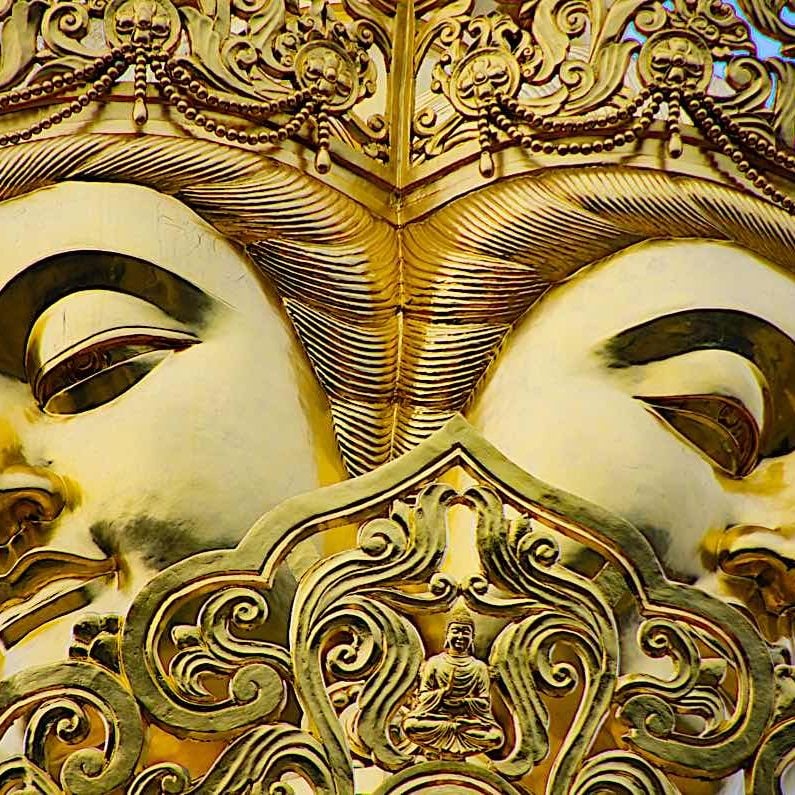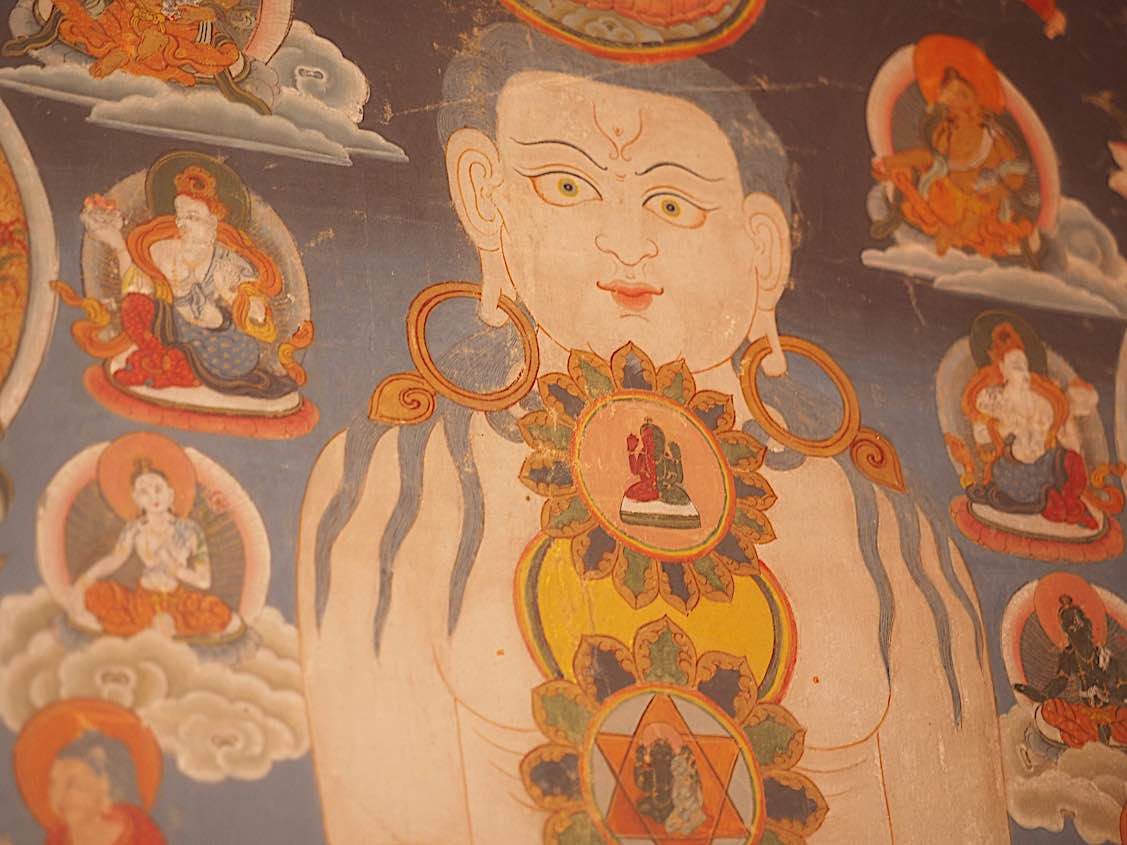Overcoming Fear: Three Remedies for Fear; What Buddha had to Say About Fearlessness in Abhaya Sutta
Today, in this time of fear in the face of a pandemic — fear has become top of mind, again. It’s easy to say, “I can’t live my life in fear” and then pretend to go about your business. But, even if you bravely brush the fear aside — in the background the nervous “look-over-your-shoulder-to-be-sure” feeling remains.
But how do we genuinely, in our hearts and minds, overcome fear? What did Buddha teach on overcoming fear? Buddha faced down not only Mara (inner demons), but also his own cousin Devadatta (who tried to kill Him more than once), charging elephants, Brahmins and falling rocks and other dangers. Iconic of His fearlessness is the hand held up in the Abhaya mudra. Who was this person, not afraid of death?

“The Buddha is seated under the Bodhi tree, looking relaxed and contemplative … Surrounding him are the maras, all of the afflictions that assail the mind. Some have spears aimed at the Buddha and some are disguised in erotic imagery, aiming to disrupt the Buddha’s concentration, trying to generate the fear that comes from being attacked. But the Buddha sits unmoved, with one hand on the ground, as if to say, “I have a right to be here.” The shield that surrounds him, that protects him from these afflictions, is his benevolence. His own loving-kindness shining out from him is the dissolver of all afflictions.” — Sylvia Boorstein [4]
Another iconic image of Buddha’s fearlessness, is the story of the rampaging elephant, enraged by wicked Devadatta. With loving kindness, and a fearless disposition, Shakyamuni instantly subdued the great beast. Devadatta tried to kill Buddha more than once, always failing.
The Abhaya mudra — the famous gesture of the Buddha holding up his hand fearlessly (seen in many images of the Buddha) — expresses Buddhist fearlessness in profound simplicity. The Enlightened Mind has no fear. But what about the rest of us? For us, those of us not Enlightened, we can take refuge in the Buddha.
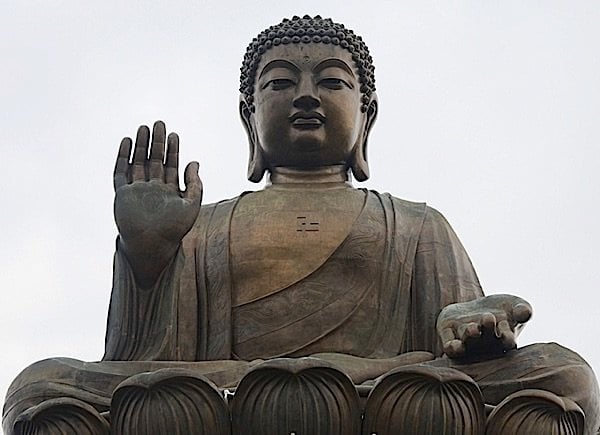
Who is this Person, Not Afraid of Death?
In the Abhaya Sutta, Shakyamuni Buddha said, “And who is the person who, subject to death, is not afraid or in terror of death? There is the case of the person who has abandoned passion, desire, fondness, thirst, fever, and craving for sensuality. Then he comes down with a serious disease. As he comes down with a serious disease, the thought does not occur to him, ‘O, those beloved sensual pleasures will be taken from me, and I will be taken from them!’ He does not grieve, is not tormented; does not weep, beat his breast, or grow delirious. This is a person who, subject to death, is not afraid or in terror of death.”
Understanding Emptiness (Oneness) Helps Overcome Fear
Thich Nhat Hanh, the great Zen teacher, not a stranger to danger, explained one of the remedies to overcome fear. He explained how understanding Oneness (Emptiness) and Dependent Arising helps us overcome fear: “The fourth notion to be thrown away is the notion of life span. We believe that we are born at one point in time, that we will die at another point in time, and that between is our life span. Most of us believe we’ll spend seventy, eighty, ninety, one hundred years on this planet and then we’ll be gone. When we look deeply, we see this is a wrong perception. In our minds, to be born means that from nothing we became something; to die means that from something we become nothing; and from someone we become no one.
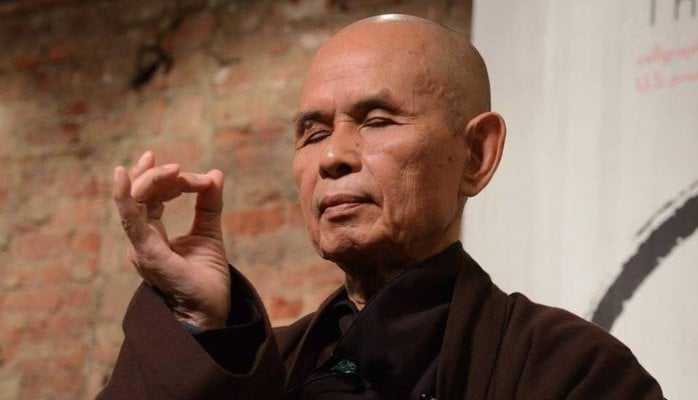
“But a cloud can’t be born; it has come from the water in the rivers and oceans, and dust and heat of the sun have helped create it. A cloud can never die; it can only become rain or snow. A piece of paper can’t be born; it’s made of trees, the sun, the cloud, the logger and the worker in the paper factory. When we burn a piece of paper, the paper is transformed into heat, ash, and smoke; it cannot be reduced to nothingness. Birth and death are notions that cannot be applied to reality.” [3]
The problem with the difficult and misunderstood concept of Oneness (Emptiness) and Dependent Arising is that it can take years of meditation to grasp them sufficiently to overcome fear.
Pragmatic Fearlessness — “Doing Good”
A more pragmatic view of fearlessness is found in the Abhaya Sutta, the “Fearless” Sutra — a discourse between the Blessed One and Janussoni the Brahman who challenged Buddha with his view “no one who, subject to death, is not afraid or in terror of death.” The Buddha answers him with four “cases” of people who would die in fear, and four who would die without fear.
Strikingly, Buddha mentions a fearless person “who has done what is good, has done what is skillful, has given protection to those in fear, and has not done what is evil, savage, or cruel. Then he comes down with a serious disease. As he comes down with a serious disease, the thought occurs to him, ‘I have done what is good, have done what is skillful, have given protection to those in fear, and I have not done what is evil, savage, or cruel… He does not grieve, is not tormented; does not weep, beat his breast, or grow delirious. This, too, is a person who, subject to death, is not afraid or in terror of death.” [2]

It’s easy to understand the notion that a good person will receive a reward —good Karma leading to good rebirth as a Buddhist belief. Yet, Buddha made it clear in the same Sutra, that the real key to freedom from fear is the person “who has abandoned passion, desire, fondness, thirst, fever, and craving for sensuality.” This person has lived the Eightfold Path, taught by Buddha, based on the Four Noble Truths. This person, who has removed attachments and craving, has no reason to fear. If you don’t feel attached to illusory enjoyments, you don’t fear losing them.
Four Types of People Free from Fear
In all, Buddha gave examples of four types of people who are free of fear. The journey away from fear is a lifetime one — not an overnight revelation. Buddha lived for eighty-years and died without fear. His followers likewise spent lifetimes living the eightfold path. At what point does fear completely disappear? In the case of Shakyamuni Buddha, that happened under the Bodhi Tree when he achieved Enlightenment. For us, we might not fully achieve fearlessness until we achieve significant realizations, or even Enlightenment.
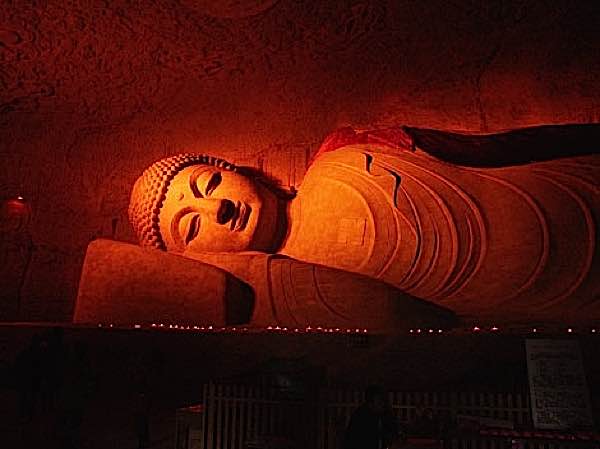
Yet, there are degrees of fear. The person who has “mostly” abandoned attachments and cravings for sensualities could probably be said to be “mostly” free from fear. The person, like the “good person” Buddha described, could also feel fulfilled, happy and content, and therefore mostly free of fear.
Some Fears are Wholesome
Reverend Zensho Susan O’Connell wrote: “Although there are some fears that seem wholesome — the fear of hurting others, the fear of death or injury that encourages us to put on our seatbelts, etc. — I believe that it is hardly ever helpful to dwell in fear or to spend more that an initial few moments breathing into it. However, to deny all fears, is just another way of providing distance from fears. Am I really fearless if I am not intimate with my fear?.” [1]
“None of us are immune to fear. Indeed, the Buddha taught that, at the base, all beings experience a state of anxiety, fed by our habit of resisting the impermanence of our existence.” [1]
Rev. O’Connel pointed out that the “antidote to fear” is not denial — pretending to be brave — but to “overcome the cause of fear … the delusion that we are unchanging beings who need to protect ourselves from what we are separate from.”
Remedy for Fear — Mindfulness
“In the Sutra on the Full Awareness of Breathing, in Pali the Anapanasati Sutta, the Buddha shows us how to transform our fear, despair, anger and craving. Breathing is a means of awakening and maintaining full attention in order to look carefully, long and deeply, see the nature of all things, and arrive at liberation.” —Thich Nhat Hanh [3]
Thich Nhat Hanh explained that being in the present moment, letting the past go, not worrying about what might come in the future, is the secret to fearlessness. The past is gone. The future isn’t here yet. If you dwell only in this moment, in this second, there is no fear. You can’t fear the future if you’re not thinking of the future. You can’t fear the loss of past memories if you’re putting aside the past.
Mindfulness is a state of “observation” — you observe your own breath, your own mind, your own body, your own actions in the present moment only. If your mind is plagued with fear, mindfulness meditation allows you to detach and observe the thoughts, analyze them, become your own teacher.
Thich Nhat Hanh explains, “Sometimes fear manifests, and our mindful breathing brings us back to our fear so we can embrace it. We look deeply into the nature of our fear to reconcile ourselves with it… transform it.” [3]
Storm Meditation
For example, let’s say you are afraid of thunder storms. Right now, in this moment, your house is shaking with the rumble of a ferocious storm. Wind lashes your house, the trees beat your roof, the windows shake. Instead of turning on the television full blast, and trying to “forget” the storm outside, Buddhist teachers might suggest you sit in meditation, listen to the storm, hear every sound, watch and observe your own fearful thoughts.
See the panic. Watch and observe in as detached a way as possible. Stay only in the present. Observe your own breath, how fast and fearful it seems, but don’t judge — simply observe. The simple act of observation, in the present moment, almost immediately slows your pulse rate, your breath and your racing, fearful thoughts.
The key to successful mindfulness is detached observation. When you first start observing your fear, you’ll still feel entangled in it. But observe even that entanglement. Don’t try to remove the entanglement, or analyze it, or destroy it — simply observe it.
Metta Remedy — “Armor of Loving Kindness”
Buddha, in the “Fearless” Sutra (below), gave the examples four people who are free from fear. He described one as he “who has done what is good, has done what is skillful, has given protection to those in fear.” [2]
Teacher Sylvia Boorstein, co-founding teaching at Spirit Rock Meditation Center, gave the example of a Zen Buddhist story to explain the “Armor of Loving Kindness.” She wrote:
“A fierce and terrifying band of samurai was riding through the countryside, bringing fear and harm wherever they went. As they were approaching one particular town, all the monks in the town’s monastery fled, except for the abbot. When the band of warriors entered the monastery, they found the abbot sitting at the front of the shrine room in perfect posture. The fierce leader took out his sword and said, “Don’t you know who I am? Don’t you know that I’m the sort of person who could run you through with my sword without batting an eye?” The Zen master responded, “And I, sir, am the sort of man who could be run through by a sword without batting an eye.”
She explained that at first she didn’t warm up to the story, “it seemed so offhanded about life.” Later, she came to understand it differently:
“Fearlessness also comes from benevolence and goodwill in the face of whatever oppresses you. You are afraid, but instead of fighting what faces you, you embrace it and accept it—you develop loving-kindness as a direct antidote to fear.” [4]
Another Remedy for Fear — Your Buddha Nature
Taking refuge in the Three Jewels, as explained by Thich Nhat Hanh, is taking refuge in your own Buddha Nature. This is a strong remedy for fear. If you understand your Buddha Nature, or the concept of Oneness with all beings, there’s no reason for fear.
Most of us aren’t that advanced.
Until we are, at least in Vajrayana and Mahayana, we can rely on meditative deities, who are expressions of the inner Buddha Nature — your Buddha within. If you practice deity meditation methods, where you visualize yourself as an Enlightened Deity, fear automatically seems to drop away.

Mantra is a “condensed” form of deity meditation. For example, Green Tara is associated with protection. Reciting her mantra — while on board an airplane that is being violently tossed in a turbulence — can calm the mind. Her mantra is:
Om Tare Tuttare Ture Svaha
Reciting it over and over, during a nerve-wracking event, is a kind of formulated mindfulness. By staying focused on Green Tara, and her active aspect as a rescuer, you are focusing on your own inner Buddha Nature.
The definition of mantra is “protection for the mind.” Mantra works at the level of your own mind. Since fear is inside your mind, and Tara is inside your heart, and the mantra is on your speech, this can be a very powerful way to calm yourself in the face of terror or fear.
Abhaya Sutta
Fearless Sutra
Translated from the Pali by Thanissaro Bhikkhu
Then Janussoni the Brahman went to the Blessed One and, on arrival, exchanged courteous greetings with him. After an exchange of friendly greetings and courtesies, he sat to one side. As he was sitting there he said to the Blessed One: “I am of the view and opinion that there is no one who, subject to death, is not afraid or in terror of death.”
The Blessed One said: “Brahman, there are those who, subject to death, are afraid and in terror of death. And there are those who, subject to death, are not afraid or in terror of death.
“And who is the person who, subject to death, is afraid and in terror of death? There is the case of the person who has not abandoned passion, desire, fondness, thirst, fever, and craving for sensuality. Then he comes down with a serious disease. As he comes down with a serious disease, the thought occurs to him, ‘O, those beloved sensual pleasures will be taken from me, and I will be taken from them!’ He grieves and is tormented, weeps, beats his breast, and grows delirious. This is a person who, subject to death, is afraid and in terror of death.
“Furthermore, there is the case of the person who has not abandoned passion, desire, fondness, thirst, fever, and craving for the body. Then he comes down with a serious disease. As he comes down with a serious disease, the thought occurs to him, ‘O, my beloved body will be taken from me, and I will be taken from my body!’ He grieves and is tormented, weeps, beats his breast, and grows delirious. This, too, is a person who, subject to death, is afraid and in terror of death.
“Furthermore, there is the case of the person who has not done what is good, has not done what is skillful, has not given protection to those in fear, and instead has done what is evil, savage, and cruel. Then he comes down with a serious disease. As he comes down with a serious disease, the thought occurs to him, ‘I have not done what is good, have not done what is skillful, have not given protection to those in fear, and instead have done what is evil, savage, and cruel. To the extent that there is a destination for those who have not done what is good, have not done what is skillful, have not given protection to those in fear, and instead have done what is evil, savage, and cruel, that’s where I’m headed after death.’ He grieves and is tormented, weeps, beats his breast, and grows delirious. This, too, is a person who, subject to death, is afraid and in terror of death.
“Furthermore, there is the case of the person in doubt and perplexity, who has not arrived at certainty with regard to the True Dhamma. Then he comes down with a serious disease. As he comes down with a serious disease, the thought occurs to him, ‘How doubtful and perplexed I am! I have not arrived at any certainty with regard to the True Dhamma!’ He grieves and is tormented, weeps, beats his breast, and grows delirious. This, too, is a person who, subject to death, is afraid and in terror of death.
“These, Brahman, are four people who, subject to death, are afraid and in terror of death.
“And who is the person who, subject to death, is not afraid or in terror of death?
“There is the case of the person who has abandoned passion, desire, fondness, thirst, fever, and craving for sensuality. Then he comes down with a serious disease. As he comes down with a serious disease, the thought does not occur to him, ‘O, those beloved sensual pleasures will be taken from me, and I will be taken from them!’ He does not grieve, is not tormented; does not weep, beat his breast, or grow delirious. This is a person who, subject to death, is not afraid or in terror of death.
“Furthermore, there is the case of the person who has abandoned passion, desire, fondness, thirst, fever, and craving for the body. Then he comes down with a serious disease. As he comes down with a serious disease, the thought does not occur to him, ‘O, my beloved body will be taken from me, and I will be taken from my body!’ He does not grieve, is not tormented; does not weep, beat his breast, or grow delirious. This, too, is a person who, subject to death, is not afraid or in terror of death.
“Furthermore, there is the case of the person who has done what is good, has done what is skillful, has given protection to those in fear, and has not done what is evil, savage, or cruel. Then he comes down with a serious disease. As he comes down with a serious disease, the thought occurs to him, ‘I have done what is good, have done what is skillful, have given protection to those in fear, and I have not done what is evil, savage, or cruel. To the extent that there is a destination for those who have done what is good, what is skillful, have given protection to those in fear, and have not done what is evil, savage, or cruel, that’s where I’m headed after death.’ He does not grieve, is not tormented; does not weep, beat his breast, or grow delirious. This, too, is a person who, subject to death, is not afraid or in terror of death.
“Furthermore, there is the case of the person who has no doubt or perplexity, who has arrived at certainty with regard to the True Dhamma. Then he comes down with a serious disease. As he comes down with a serious disease, the thought occurs to him, ‘I have no doubt or perplexity. I have arrived at certainty with regard to the True Dhamma.’ He does not grieve, is not tormented; does not weep, beat his breast, or grow delirious. This, too, is a person who, subject to death, is not afraid or in terror of death.
“These, Brahman, are four people who, subject to death, are not afraid or in terror of death.”
When this was said, Janussoni the Brahman said to the Blessed One: “Magnificent, Master Gotama! Magnificent! Just as if he were to place upright what was overturned, to reveal what was hidden, to show the way to one who was lost, or to carry a lamp into the dark so that those with eyes could see forms, in the same way has Master Gotama — through many lines of reasoning — made the Dhamma clear. I go to Master Gotama for refuge, to the Dhamma, and to the Sangha of monks. May Master Gotama remember me as a lay follower who has gone to him for refuge, from this day forward, for life.”
NOTES
[1] “What are you afraid of? Cultivating fearlessness in Buddhism” Huffington Post https://www.huffingtonpost.com/rev-zesho-susan-oconnell/what-are-you-afraid-of_b_1079091.html
[2] Abhaya Sutta, Translated from the Pali by Thanissaro Bhikkhu [Full text above in English.]
[3] Commentary on the Sutra of the Middle Way, from Awakening of the Heart, by Thich Nhat Hanh
[4] “Fear and Fearlessness”, Lion’s Roar, June 7, 2016
More articles by this author
Search
Latest Features
Please support the "Spread the Dharma" mission as one of our heroic Dharma Supporting Members, or with a one-time donation.
Please Help Support the “Spread the Dharma” Mission!

Be a part of the noble mission as a supporting member or a patron, or a volunteer contributor of content.
The power of Dharma to help sentient beings, in part, lies in ensuring access to Buddha’s precious Dharma — the mission of Buddha Weekly. We can’t do it without you!
A non-profit association since 2007, Buddha Weekly published many feature articles, videos, and, podcasts. Please consider supporting the mission to preserve and “Spread the Dharma." Your support as either a patron or a supporting member helps defray the high costs of producing quality Dharma content. Thank you! Learn more here, or become one of our super karma heroes on Patreon.
Lee Kane
Author | Buddha Weekly
Lee Kane is the editor of Buddha Weekly, since 2007. His main focuses as a writer are mindfulness techniques, meditation, Dharma and Sutra commentaries, Buddhist practices, international perspectives and traditions, Vajrayana, Mahayana, Zen. He also covers various events.
Lee also contributes as a writer to various other online magazines and blogs.




